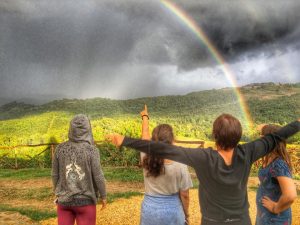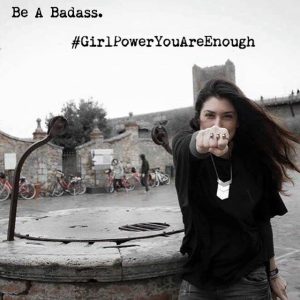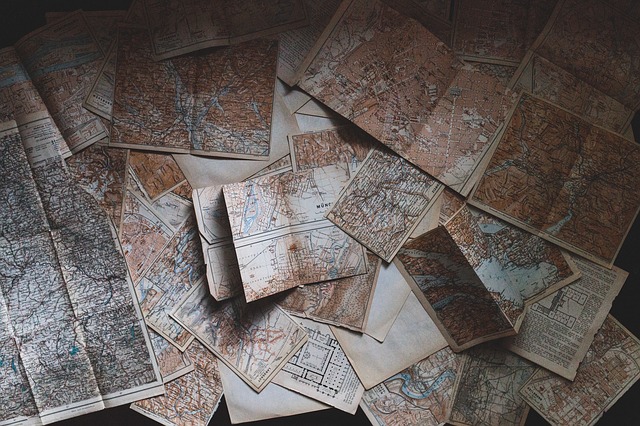By Josephine Ensign
This is a test of your mental state.1
- Where are you right now? (But first: Who are you? What’s the story of your true name?)
- What’s the date—day, month, year? (Where did you come from and where are you headed?)
- Repeat these three words after me: whale, map, stone. (Don’t question them; they’re important words.)
- Spell world backwards. (Now spell world spinning.)
- Repeat the phrase: ‘A rolling stone gathers no moss.’ What do you suppose it means? (Be careful of your answer. It can indicate instability.)
- Take these stones in your right hand. Roll them slowly in your hand like dice. Drop them on the floor. (Repeat. Gently, rhythmically. Imagine ocean waves lapping the shores of a pebbled beach.)
- Write a sentence. (Now write another sentence connected with the first. Repeat.)
- Tell me the names of the three items I gave you earlier. (Remember them? Whale, map, stone….)
_________________________________________
Whale.
August 11, 1980. Time: 1720/ Position: 49.39 degrees N, 60.29 degrees W. Sea level. Banc Beauge, Gulf of Saint Lawrence, Canada.
Call me Josephine, although at the time I went by my childhood nickname: BJ. I’ve just turned nineteen and I’m at the helm of the Westward, a 125-foot topsail schooner oceanographic research vessel out of Woods Hole, Cape Cod, Massachusetts. We’re under full sail. I’m steering a course SE toward Lark Harbour, Bay of Islands, Newfoundland. I glance down at the glass globe crystal ball of the compass binnacle in front of me. We’ve been blown off-course by a Force Nine gale lasting two days and nights. Today it’s passed by to the north, leaving us in sight of the desolate flat-lined coast of Labrador. The heavy grey clouds undulate above us, breaking in places to lapis sky. The breeze is stiff and steady, whipping small white-frothed waves against our hull.
The air smells of briny salt, earthy teak from the ship’s decking, and tobacco. Standing beside me is Captain Chase, whose chiseled profile, neatly trimmed blond mustache, and pipe are in my peripheral vision. He’s gazing ahead when a low siren explosion sounds to our port side, accompanied by a 30-foot tall spout of seawater. The breeze changes to include a fetid fish smell. There’s a 70-foot blue whale just yards from our boat. The Captain calmly yells, “Prepare to come about!”
We’re part of an ongoing study of whales in the Gulf of Saint Lawrence and have seen numerous pods of pilot whales, along with minke, fin, and humpback whales. But this is our first sighting of a blue whale, Balaenopotera musculus. They’re elusive, solitary, and migratory. They’re also the largest animals ever to have lived on earth—almost twice as large as the largest land or sea dinosaur. No photograph, no video—not even 3D IMAX—can come close to replicating the feeling of being there. It’s awesome; it’s awful.
This isn’t my big fish tale. What’s important is the context, the exact location, the time, the sea and landmarks, of a fixed point of memory I carry with me. Why do some memories stay and others flee?
Map.
In the early 1990s I worked with teens who were thrownaway, runaway, tossed about and spat out onto the menacing streets of Baltimore. Huddled in small groups in emergency shelters, I gave them colored markers, stickers, and large sheets of paper, and asked them to draw a map of their neighborhood—wherever it was in Baltimore with which they were most familiar. Their maps always included Charles Street as their North-South meridian. They were either East or West Baltimorians. For many of the teens, their parents and grandparents had never ventured across Charles Street, had never traveled outside their immediate neighborhoods. They didn’t find this strange.
I was a nurse working on my doctorate in international public health. I’d wanted to become a biologist, a naturalist who studied the migratory patterns of fish and whales; instead, I’d become a nurse. I’d been thrown off-course. But now I was finding my way back.
We develop cognitive maps—mental maps, mind’s eye maps—through exploring our environment, studying actual maps, and hearing information about our world. The community mapping exercise I did with Baltimore teens charted their mental maps. I asked them to locate their main hangout areas, to tell me why some were safe and others unsafe. At the time, Baltimore had the highest murder rate of any city in the U.S., one of the highest rates in the world. For these young people, their maps were urban warfare tactical maps—strategies for survival.
I rowed a single in the waters of Baltimore. Balanced in a sleek racing shell, holding a sculling oar in each hand, I navigated around orange-buoyed Superfund contamination sites, submerged ships and refrigerators, and through curtains of dangling chicken necks suspended by crab-hunting strings to low-lying bridges. The air I breathed while rowing smelled of urine, iron, and rotten flesh. On our rowing house dock my feet crunched waves of tiny glass crack vials washed up by the tide. I memorized the maps of the Patapsco River, the Middle Branch, and Inner Harbor waters on which I rowed. I can still tell you exactly where the shoal of dumped appliances lies.
Buried deep inside our brains, in the primitive limbic system, are cells that record our movement, our navigation through time and space: place cells, grid cells, border cells. These are our mental map cells. The way the brain records and remembers movement in space appears to be the basis of all memory. Place cells encode spatial information layered with sensory input from our environment to become associated with particular experiences: memories. We are born with rudimentary internal cognitive maps that we add to over our lifetimes, creating a mosaic of map-bits and scene constructions.
The memory of the briefest of events can last a lifetime. Where on the coordinates of our memory maps do our first memories reside? Do these first memories define us? Do they point us in specific directions? In mine I am three. It’s late afternoon of a rainy summer day in Virginia. I’m lying in bed, swaddled in the primordial smell of moist humus and the lush leafy gleam coming through the open windows. On the green shag rug are pieces of white typing paper with penciled scribbles. I’m alone in my room, drowsy, deeply, achingly content.
Stone.
They are my runes, my lots. The memory, the fixed point, is embedded in two white stones I’ve carried with me since finding them in the waters of the blue whale. These are my Jonah’s stones. They didn’t come from the whale; they came from the inner ears of a large white cod caught in nets while we sampled pink krill the whale was feeding on. I was studying the swim bladders—primitive lungs—and inner ears of bony fish.
The stones are called otoliths: Greek for ear stones. All vertebrates, including humans, have otoliths, although some, like ours, are microscopic. The stones are suspended in fluid in the labyrinths of the inner ear. They aid in perception of sound and gravitational forces, in maintenance of balance and orientation—of direction. Otoliths are part of ultrasonic speech perception in humans: we can discern speech beyond our hearing range. Listen carefully to that fact. Do you hear voices others can’t hear?
We are more influenced by our physical environment than we are comfortable acknowledging. Sensory stimuli that we filter out or that are present below a detectable level influence our decisions, induce subliminal learning, and are stored with specific memories. Place is part of us; place lives in us.
My otoliths, the two from the white cod, live in a small tin pillbox, with the image of an English thatched-roof cottage printed on it. I bought the tin in a small fishing village built on stilts along the pebbled edge of a tranquil Newfoundland fjord. The otoloiths are pearly white, curled like mummified embryos. Similar to seashells, they’re composed of calcium carbonate absorbed from the waters, their layers analogous to growth rings of trees: a new layer for each year of life. The otoliths have stayed with me, have become my talismans.
Take these stones in your right hand. Roll them slowly in your hand like dice. Drop them on the floor. (Repeat. Gently, rhythmically. Imagine ocean waves lapping the shores of a pebbled beach.)
____________________________________________________
Remember them? Whale, map, stone….
March 27, 2014. Time: 13:30/ Position: 35.58 degrees S, 173.30 degrees E. Sea level. Waimamaku Beach, Northland, New Zealand.
Call me Josephine. This is the story of my true name.
I’m fifty-three years old and am floating naked in a rock pool filled with cold water from the Tasman Sea. The low tide has exposed large slabs of black volcanic rock—basalt scoria with frozen-in-time bubbles of Miocene-era lava gas. The rocks shelter me from the open sea. Fine salt mist from the crashing waves settles on my face, my lips, my tongue. Above me are layers of leaden grey clouds. In the rock pool are small bright purple and orange crabs, silver minnows, pink sea fans, green-lipped mussels, and burnt-orange starfish. On the exposed rocks above me are fringes of chartreuse green sea lettuce, undulating dreadlocks of dun green sea kelp, and a flock of orange-beaked, pink-footed oystercatchers. I’m cradled in an impossibly psychedelic crayon-colored landscape. I arch my back, duck my head below water, and emerge to see that it is real; I am not drunk or on drugs or crazy.
Spell world backwards. (Now spell world spinning.)
The night before, I stood on a treeless hilltop studying the clear nighttime sky. Far from any city lights, the sky was ink black, startling in proximity of stars and Milky Way. As I searched for Orion, the anchor for me in direction finding at night, I realized the constellation was upside down, rotated and reversed left to right. It lies in the northern sky versus the southern for me at home in the Northern Hemisphere. And, forgetting where I was, I looked in vain for the Big Dipper and the North Star, before recognizing the Southern Cross. Inside the Milky Way were small white puffs I first mistook for passing clouds, and then realized they were galaxies I’d never seen.
Entering a new and dramatic territory can make us realize the potency of place; it can make us sense our embodiment of place. While being within such a dislocating experience we are literally and figuratively out of place. That’s what happened to me on the hilltop that night. I stood outside for hours trying to regain my bearings, my balance, my location. Only the growing awareness of being stung by silent stealth mosquitoes brought me back to my body, to the ground beneath my bare feet, and to my bed with dreams of new geographies.
Repeat the phrase: ‘A rolling stone gathers no moss.’ What do you suppose it means? (Be careful of your answer. It can indicate instability.)
A common brain network underlies memory and imagination, including future thinking. Both are mental time travel. Past events of great importance that shape a person’s sense of identity are manifested similarly in the construction of self-defining future projects and experiences; they are self-defining and directional memories. Since the past and the future are part of us, it is not only the present that matters.
I’m at the end of my three-month stay in New Zealand. I’ve just finished teaching a university study abroad program with sixteen college juniors—all young women. They returned home to Seattle last week, taking with them their questions about careers and future trajectories. Floating in the rock pool beside the Tasman Sea I ask myself a question I posed to my students at the end of their journeys: Where did you come from and where are you headed?
In the still point between the crashing waves of the wild Tasman Sea, I know that this is my self-defining, directional memory as it is being made: a memory I know I will have even while it is—and was—occurring.
Write a sentence. (Now write another sentence connected with the first. Repeat.)
__________________________________________________________________________
Note:
- The mental test items presented at the beginning of this essay are based on the mini-mental state examination (MMSE), a common neurocognitive test used by health professionals to screen patients for dementia or other cognitive deficits. The questions and instructions included in parentheses are ones I created.
Josephine Ensign teaches health policy, health humanities, and community health at the University of Washington in Seattle. She is an alumna of Hedgebrook, the Jack Straw Writers Program, and the Community of Writers at Squaw Valley. Her essays have appeared in The Sun, Front Porch Journal, The Oberlin Alumni Magazine, Pulse: Voices from the Heart of Medicine, Silk Road, The Intima, Electric Literature/Okey-Panky, The Examined Life Journal, Johns Hopkins Public Health Magazine, and in the nonfiction anthology: I Wasn’t Strong Like This When I Started Out: True Stories of Becoming a Nurse edited by Lee Gutkind. Her medical memoir, Catching Homelessness: A Nurse’s Story of Falling Through the Safety Net (Berkeley: She Writes Press, 2016) was selected as the UW Health Sciences Common Book for academic year 2016/17. She has completed her second nonfiction book manuscript, Soul Stories: Voices from the Margins, about the role of narrative in health and healing in the context of trauma.


Get ready to connect to your joy, manifest the life of your dreams, and tell the truth about who you are. This program is an excavation of the self, a deep and fun journey into questions such as: If I wasn’t afraid, what would I do? Who would I be if no one told me who I was?
Jennifer Pastiloff, creator of Manifestation Yoga and author of the forthcoming Girl Power: You Are Enough, invites you beyond your comfort zone to explore what it means to be creative, human, and free—through writing, asana, and maybe a dance party or two! Jennifer’s focus is less on yoga postures and more on diving into life in all its unpredictable, messy beauty.
Note Bring a journal, an open heart, and a sense of humor. Click the photo to sign up.
